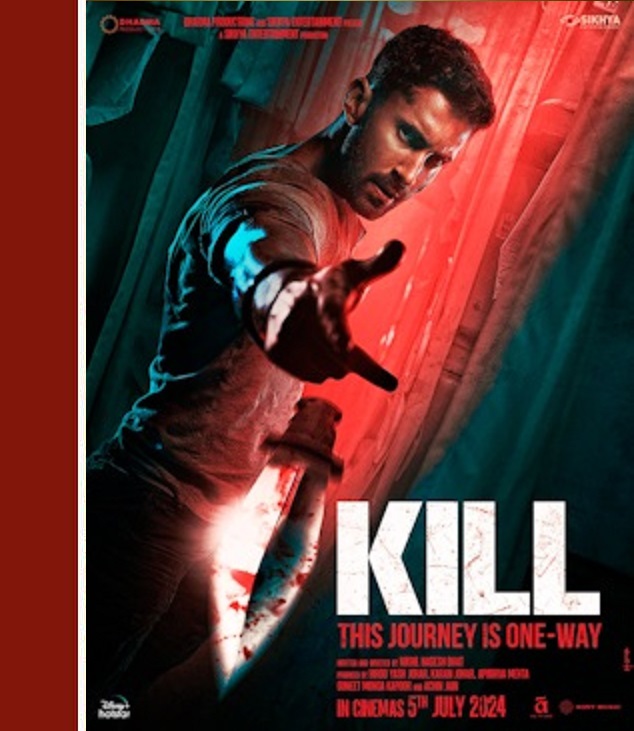Actions have consequences.
Violence begets violence.
And violent actions have
Even more violent consequences.
This seems to be the philosophy of Nikhil Nagesh Bhat’s film Kill (2024). It takes the action genre to its limits, entering into the territories of ultra-violence. Depiction of violence in cinema can sometimes fall flat, with graphic violence not achieving anything other than generating a reaction from the audience. Kill, however, employs violent action sequences in such a way, that even with its over-the-top iteration, it never feels forced. Most of the shot lengths during the perfectly executed, MMA-inspired fight sequences are not as short as you’d expect in a typical fight sequence; this allows the viewers to follow the actors’ movements more closely, turning it into an immersive experience. Aided by this, the plot elements propel the violent events to take place.
Such kinds of action films, where we see a single man take on and decimate multiple opponents, usually require a greater suspension of disbelief, which should be allowed to occur smoothly in the mind of the viewer. If it is forced, then the viewer will automatically be disengaged from the story; and the action sequences, no matter how well-choreographed, can become objects of ridicule and turn inconsequential in terms of having any kind of emotional impact. Action thrillers need to be “engaging” — this is not just a hackneyed tip from screenwriting 101; ensuring audience engagement should be at the heart of such films. If one feels distanced even during the over-the-top fight scenes, the film would fail to leave any lasting impact on the viewer. This is where Kill is successful. Additionally, I feel that Kill manages to grab the audience’s attention and involvement largely through its form rather than through its content.
We are introduced to the protagonist Amrit Rathod (Lakshya), an NSG commando who is about to go back home after successfully completing a mission. He is not shown fighting in the battlefield or performing superhuman feats. Instead, he is introduced using the kinds of shots (taken from multiple angles and in slow-motion) and accompanying background music (heavy and triumphant) that have become the staple of introducing formidable action movie protagonists. Although Kill is Lakshya’s debut feature film, this kind of an introduction immediately legitimises him as an already-established action hero, fit to elicit cheers and applauds from a raucous crowd. We immediately learn about his girlfriend Tulika (Tanya Maniktala), and the issue caused by her father. This appears to be the main conflict, a classic trope that has been reiterated countless number of times — the rich and influential father has fixed his daughter’s marriage with someone of his choice, while the daughter is in love with someone else, a poor or middle-class bloke (usually the protagonist), who has two options: either win over the father, or elope. The writers of Kill, Ayesha Syed and Nikhil Nagesh Bhat, tweak this classic template. First, the protagonist is not just a regular guy — he is a member of the Armed Forces, and is not afraid of taking drastic steps to get what he wants. Second, the father is not really the antagonistic force in the story. Instead, he becomes a liability to the protagonist. The evil in the film are outsiders. They intrude into the classic trope that the film seems to be premised upon, causing all hell to break loose.
The setting, a moving train, helps to amplify the tension both physically and mentally. Limiting the space, the protagonist becomes susceptible to unexpected dangers. The audience, too, gets trapped in this space, in this claustrophobic environment. It also gives the action sequences a distinct visceral quality.

The question “How much violence is too much violence?” has been asked so many times in the fields of literature and cinema that it has become somewhat banal at this point.
Kill surpasses the expectations of the level of violence one would assume to see in an Indian action film, taking it up several notches. Bloodshed has been an important, recurring element of Indian popular cinema in the 1970s and 1980s. Kung Fu-inspired combat, resounding gunshots, explosions, and brutal murders can be seen throughout Amitabh Bachchan’s “Angry Young Man” films. However, the graphic nature of those depictions were toned down to a large extent. The most one would get to see was an unnatural amount of bloodshed. The bloodshed of Kill looks as real as it gets. It makes the audience feel the action up close. The sounds of flesh being punctured, seared, and slashed, and the visuals of blood getting splattered all over the place — these effects are not only meticulously designed, but also presented in such a way that it makes the viewer uncomfortable yet engrossed in an oddly satisfying way. This satisfaction is the result of the cathartic nature of violence in the film.
The question “How much violence is too much violence?” has been asked so many times in the fields of literature and cinema that it has become somewhat banal at this point. Attempts have been made to answer this question, but a decisive, agreeable answer has not been reached (and can never be reached), as it always yields polarising opinions. But there is a problem with the question itself. When it comes to the depiction of violence in media, this actually becomes a trick question. It presupposes the notion that there is indeed something that could be termed as “too much violence,” addressing which is usually the motive of raising the question in the first place. But violence, in all its depictions, is highly contextual. Regardless of how “real” or brutal a violent scene looks, if it doesn’t engage the audience on a psychological level, it doesn’t really pay off. An act of revenge is always going to be violent, but if it doesn’t lead to some form of catharsis, it becomes pointless.
In Kill, an act of violence triggers a chain of cause and effect, creating a violent change in the protagonist. In order to deal with this change, and as a response to the initial act of violence, he has to take a bloody path of vengeance. This makes every action on his part, no matter how brutal or inhuman, seem justifiable. This enables the viewers to get emotionally involved during as the events unfold, and the gradual release of tension is facilitated with every blow the protagonist lands on his adversaries.
This is how Kill becomes cathartic in its depiction and treatment of violence, where other recent Hindi action films (like Animal) have failed.
Kill turns reflexive at one point, where its over-the-top violence is addressed by one of the antagonists, who, after witnessing the mayhem caused by the protagonist, comments: “Who kills like that?”
The only part where Kill falls short is in the dimensionality of its characters. Considering the fact that most of the film’s runtime is dedicated to the action sequences, the most important human relationship in the film, that of Amrit and Tulika, actually feels insignificant. The film is so saturated with frenzied action and bloodshed, that the “calmer” moments pertaining to the protagonist’s relationship become increasingly difficult to connect with or care for. That, however, doesn’t really become much of a hindrance as the moments of action are treated as the heart and soul of the film. They are carried out with great finesse, keeping the audience on the edge of their seats. Due to the film’s fast pace and the continually turning action-reaction wheel that it rolls on, this drawback doesn’t affect the overall viewing experience.
The influence of the 1970s and 1980s martial arts films on Kill is quite obvious. There are also scenes in the film that seem to be inspired by classics such as Snowpiercer (2013), Oldboy (2003), John Wick (2014), Irreversible (2002), and also the films of Quentin Tarantino.
SPOILER ALERT:
The film’s final scene was highly reminiscent of the last scene of Ghajini (2008), but I felt that it failed to deliver the gut punch that was offered by Ghajini’s ending. Kill is almost entirely focused on a series of violent actions and their consequences, where character development takes the backseat. The tragedy of Ghajini, on the other hand, was the fate of its main characters and their relationship, which was intimately explored throughout the film. Being two completely different films, the similar final scenes have completely different effects on the viewer. Both films, however, remind us of what the protagonist has lost and can never get back.
Revenge thrillers thrive on violence, but there is a thin line between gratuitous violence and cathartic violence. Both are enjoyable, as long as they are applied properly, congruent with the requirements of the story. However, if one is used in tandem with the other, both the entertainment factor and the emotional factor of a film can be maximised. Kill manages to do this well, while at the same time reminding us that every act of vengeance is, at the end of the day, gratuitous.
Aditya Modak
Runner-up of the FIPRESCI-India 2023 competition for the best upcoming film reviewer, he writes for the FCCI Journal of Indian Cinema, and is also the author of a fiction novel, ‘Arachnid’. He is presently doing his PhD in Film Studies at Jadavpur University.

Share Widely



